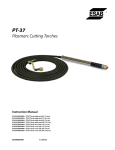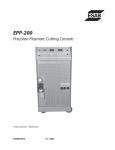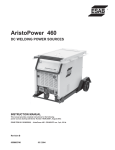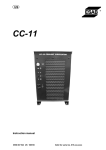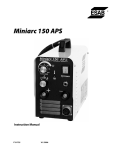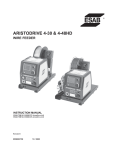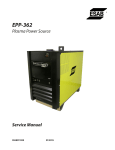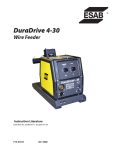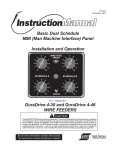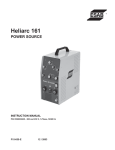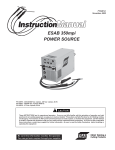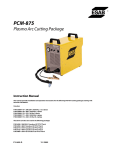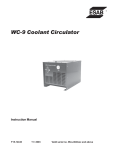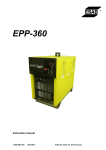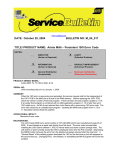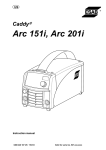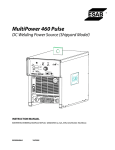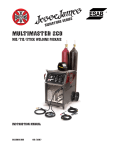Download PP36 Plus Push-Pull MIG Welding Gun
Transcript
PP36 Plus Push-Pull MIG Welding Gun Instruction Manual 0558011520 June 30, 2011 Be sure this information reaches the operator. You can get extra copies through your supplier. caution These INSTRUCTIONS are for experienced operators. If you are not fully familiar with the principles of operation and safe practices for arc welding and cutting equipment, we urge you to read our booklet, “Precautions and Safe Practices for Arc Welding, Cutting, and Gouging,” Form 52-529. Do NOT permit untrained persons to install, operate, or maintain this equipment. Do NOT attempt to install or operate this equipment until you have read and fully understand these instructions. If you do not fully understand these instructions, contact your supplier for further information. Be sure to read the Safety Precautions before installing or operating this equipment. USER RESPONSIBILITY This equipment will perform in conformity with the description thereof contained in this manual and accompanying labels and/or inserts when installed, operated, maintained and repaired in accordance with the instructions provided. This equipment must be checked periodically. Malfunctioning or poorly maintained equipment should not be used. Parts that are broken, missing, worn, distorted or contaminated should be replaced immediately. Should such repair or replacement become necessary, the manufacturer recommends that a telephone or written request for service advice be made to the Authorized Distributor from whom it was purchased. This equipment or any of its parts should not be altered without the prior written approval of the manufacturer. The user of this equipment shall have the sole responsibility for any malfunction which results from improper use, faulty maintenance, damage, improper repair or alteration by anyone other than the manufacturer or a service facility designated by the manufacturer. READ AND UNDERSTAND THE INSTRUCTION MANUAL BEFORE INSTALLING OR OPERATING. PROTECT YOURSELF AND OTHERS! section 1 1.0Safety Precautions WARNING: These Safety Precautions are for your protection. They summarize precautionary information from the references listed in Additional Safety Information section. Before performing any installation or operating procedures, be sure to read and follow the safety precautions listed below as well as all other manuals, material safety data sheets, labels, etc. Failure to observe Safety Precautions can result in injury or death. PROTECT YOURSELF AND OTHERS -Some welding, cutting, and gouging processes are noisy and require ear protection. The arc, like the sun, emits ultraviolet (UV) and other radiation and can injure skin and eyes. Hot metal can cause burns. Training in the proper use of the processes and equipment is essential to prevent accidents. Therefore: 1. Always wear safety glasses with side shields in any work area, even if welding helmets, face shields, and goggles are also required. 2. Use a face shield fitted with the correct filter and cover plates to protect your eyes, face, neck, and ears from sparks and rays of the arc when operating or observing operations. Warn bystanders not to watch the arc and not to expose themselves to the rays of the electric-arc or hot metal. 3. Wear flameproof gauntlet type gloves, heavy longsleeve shirt, cuffless trousers, high-topped shoes, and a welding helmet or cap for hair protection, to protect against arc rays and hot sparks or hot metal. A flameproof apron may also be desirable as protection against radiated heat and sparks. 4. Hot sparks or metal can lodge in rolled up sleeves, trouser cuffs, or pockets. Sleeves and collars should be kept buttoned, and open pockets eliminated from the front of clothing. 5. Protect other personnel from arc rays and hot sparks with a suitable non-flammable partition or curtains. 6. Use goggles over safety glasses when chipping slag or grinding. Chipped slag may be hot and can fly far. Bystanders should also wear goggles over safety glasses. safety precautions 1.1Safety - English FIRES AND EXPLOSIONS -- Heat from flames and arcs can start fires. Hot slag or sparks can also cause fires and explosions. Therefore: 1. Remove all combustible materials well away from the work area or cover the materials with a protective non-flammable covering. Combustible materials include wood, cloth, sawdust, liquid and gas fuels, solvents, paints and coatings, paper, etc. 2. Hot sparks or hot metal can fall through cracks or crevices in floors or wall openings and cause a hidden smoldering fire or fires on the floor below. Make certain that such openings are protected from hot sparks and metal.“ 3. Do not weld, cut or perform other hot work until the workpiece has been completely cleaned so that there are no substances on the workpiece which might produce flammable or toxic vapors. Do not do hot work on closed containers. They may explode. 4. Have fire extinguishing equipment handy for instant use, such as a garden hose, water pail, sand bucket, or portable fire extinguisher. Be sure you are trained in its use. 5. Do not use equipment beyond its ratings. For example, overloaded welding cable can overheat and create a fire hazard. 6. After completing operations, inspect the work area to make certain there are no hot sparks or hot metal which could cause a later fire. Use fire watchers when necessary. 7. For additional information, refer to NFPA Standard 51B, "Fire Prevention in Use of Cutting and Welding Processes", available from the National Fire Protection Association, Batterymarch Park, Quincy, MA 02269. ELECTRICAL SHOCK -- Contact with live electrical parts and ground can cause severe injury or death. DO NOT use AC welding current in damp areas, if movement is confined, or if there is danger of falling. section 1 safety precautions 1. Be sure the power source frame (chassis) is connected to the ground system of the input power. 3. Welders should use the following procedures to minimize exposure to EMF: 2. Connect the workpiece to a good electrical ground. A.Route the electrode and work cables together. Secure them with tape when possible. 3. Connect the work cable to the workpiece. A poor or missing connection can expose you or others to a fatal shock. B. Never coil the torch or work cable around your body. 4. Use well-maintained equipment. Replace worn or damaged cables. 5. Keep everything dry, including clothing, work area, cables, torch/electrode holder, and power source. 6. Make sure that all parts of your body are insulated from work and from ground. C.Do not place your body between the torch and work cables. Route cables on the same side of your body. D.Connect the work cable to the workpiece as close as possible to the area being welded. E. Keep welding power source and cables as far away from your body as possible. 7. Do not stand directly on metal or the earth while working in tight quarters or a damp area; stand on dry boards or an insulating platform and wear rubber-soled shoes. 8. Put on dry, hole-free gloves before turning on the power. 9. Turn off the power before removing your gloves. 10. Refer to ANSI/ASC Standard Z49.1 (listed on next page) for specific grounding recommendations. Do not mistake the work lead for a ground cable. ELECTRIC AND MAGNETIC FIELDS — May be dangerous. Electric current flowing through any conductor causes localized Electric and Magnetic Fields (EMF). Welding and cutting current creates EMF around welding cables and welding machines. Therefore: 1. Welders having pacemakers should consult their physician before welding. EMF may interfere with some pacemakers. 2. Exposure to EMF may have other health effects which are unknown. Therefore: FUMES AND GASES -- Fumes and gases, can cause discomfort or harm, particularly in confined spaces. Do not breathe fumes and gases. Shielding gases can cause asphyxiation. 1. Always provide adequate ventilation in the work area by natural or mechanical means. Do not weld, cut, or gouge on materials such as galvanized steel, stainless steel, copper, zinc, lead, beryllium, or cadmium unless positive mechanical ventilation is provided. Do not breathe fumes from these materials. 2. Do not operate near degreasing and spraying operations. The heat or arc rays can react with chlorinated hydrocarbon vapors to form phosgene, a highly toxic gas, and other irritant gases. 3. If you develop momentary eye, nose, or throat irritation while operating, this is an indication that ventilation is not adequate. Stop work and take necessary steps to improve ventilation in the work area. Do not continue to operate if physical discomfort persists. 4. Refer to ANSI/ASC Standard Z49.1 (see listing below) for specific ventilation recommendations. section 1 5.WARNING:This product, when used for welding or cutting, produces fumes or gases which contain chemicals known to the State of California to cause birth defects and, in some cases, cancer. (California Health & Safety Code §25249.5 et seq.) CYLINDER HANDLING -- Cylinders, if mishandled, can rupture and violently release gas. Sudden rupture of cylinder, valve, or relief device can injure or kill. Therefore: 1. Use the proper gas for the process and use the proper pressure reducing regulator designed to operate from the compressed gas cylinder. Do not use adaptors. Maintain hoses and fittings in good condition. Follow manufacturer's operating instructions for mounting regulator to a compressed gas cylinder. 2. Always secure cylinders in an upright position by chain or strap to suitable hand trucks, undercarriages, benches, walls, post, or racks. Never secure cylinders to work tables or fixtures where they may become part of an electrical circuit. 3. When not in use, keep cylinder valves closed. Have valve protection cap in place if regulator is not connected. Secure and move cylinders by using suitable hand trucks. Avoid rough handling of cylinders. 4. Locate cylinders away from heat, sparks, and flames. Never strike an arc on a cylinder. 5. For additional information, refer to CGA Standard P-1, "Precautions for Safe Handling of Compressed Gases in Cylinders", which is available from Compressed Gas Association, 1235 Jefferson Davis Highway, Arlington, VA 22202. EQUIPMENT MAINTENANCE -- Faulty or improperly maintained equipment can cause injury or death. Therefore: safety precautions 1. Always have qualified personnel perform the installation, troubleshooting, and maintenance work. Do not perform any electrical work unless you are qualified to perform such work. 2. Before performing any maintenance work inside a power source, disconnect the power source from the incoming electrical power. 3. Maintain cables, grounding wire, connections, power cord, and power supply in safe working order. Do not operate any equipment in faulty condition. 4. Do not abuse any equipment or accessories. Keep equipment away from heat sources such as furnaces, wet conditions such as water puddles, oil or grease, corrosive atmospheres and inclement weather. 5. Keep all safety devices and cabinet covers in position and in good repair. 6. Use equipment only for its intended purpose. Do not modify it in any manner. ADDITIONAL SAFETY INFORMATION -- For more information on safe practices for electric arc welding and cutting equipment, ask your supplier for a copy of "Precautions and Safe Practices for Arc Welding, Cutting and Gouging", Form 52-529. The following publications, which are available from the American Welding Society, 550 N.W. LeJuene Road, Miami, FL 33126, are recommended to you: 1. ANSI/ASC Z49.1 - "Safety in Welding and Cutting" 2. AWS C5.1 - "Recommended Practices for Plasma Arc Welding" 3. AWS C5.2 - "Recommended Practices for Plasma Arc Cutting" 4. AWS C5.3 - "Recommended Practices for Air Carbon Arc Gouging and Cutting" section 1 safety precautions 5. AWS C5.5 - "Recommended Practices for Gas Tungsten Arc Welding“ 6. AWS C5.6 - "Recommended Practices for Gas Metal Arc Welding"“ 7. AWS SP - "Safe Practices" - Reprint, Welding Handbook. 8. ANSI/AWS F4.1, "Recommended Safe Practices for Welding and Cutting of Containers That Have Held Hazardous Substances." Meaning of symbols - As used throughout this manual: Means Attention! Be Alert! Your safety is involved. Means immediate hazards which, if not avoided, will result in immediate, serious personal injury or loss of life. Means potential hazards which could result in personal injury or loss of life. Means hazards which could result in minor personal injury. secCION 1 1.2Safety - Spanish ADVERTENCIA: Estas Precauciones de Seguridad son para su protección. Ellas hacen resumen de información proveniente de las referencias listadas en la sección "Información Adicional Sobre La Seguridad". Antes de hacer cualquier instalación o procedimiento de operación , asegúrese de leer y seguir las precauciones de seguridad listadas a continuación así como también todo manual, hoja de datos de seguridad del material, calcomanias, etc. El no observar las Precauciones de Seguridad puede resultar en daño a la persona o muerte. PROTEJASE USTED Y A LOS DEMAS-Algunos procesos de soldadura, corte y ranurado son ruidosos y requiren protección para los oídos. El arco, como el sol , emite rayos ultravioleta (UV) y otras radiaciones que pueden dañar la piel y los ojos. El metal caliente causa quemaduras. EL entrenamiento en el uso propio de los equipos y sus procesos es esencial para prevenir accidentes. Por lo tanto: 1. Utilice gafas de seguridad con protección a los lados siempre que esté en el área de trabajo, aún cuando esté usando careta de soldar, protector para su cara u otro tipo de protección. 2. Use una careta que tenga el filtro correcto y lente para proteger sus ojos, cara, cuello, y oídos de las chispas y rayos del arco cuando se esté operando y observando las operaciones. Alerte a todas las personas cercanas de no mirar el arco y no exponerse a los rayos del arco eléctrico o el metal fundido. 3. Use guantes de cuero a prueba de fuego, camisa pesada de mangas largas, pantalón de ruedo liso, zapato alto al tobillo, y careta de soldar con capucha para el pelo, para proteger el cuerpo de los rayos y chispas calientes provenientes del metal fundido. En ocaciones un delantal a prueba de fuego es necesario para protegerse del calor radiado y las chispas. 4. Chispas y partículas de metal caliente puede alojarse en las mangas enrolladas de la camisa , el ruedo del pantalón o los bolsillos. Mangas y cuellos deberán mantenerse abotonados, bolsillos al frente de la camisa deberán ser cerrados o eliminados. 5. Proteja a otras personas de los rayos del arco y chispas calientes con una cortina adecuada no-flamable como división. 6. Use careta protectora además de sus gafas de seguridad cuando esté removiendo escoria o puliendo. sEGURIDAD La escoria puede estar caliente y desprenderse con velocidad. Personas cercanas deberán usar gafas de seguridad y careta protectora. FUEGO Y EXPLOSIONES -- El calor de las flamas y el arco pueden ocacionar fuegos. Escoria caliente y las chispas pueden causar fuegos y explosiones. Por lo tanto: 1. Remueva todo material combustible lejos del área de trabajo o cubra los materiales con una cobija a prueba de fuego. Materiales combustibles incluyen madera, ropa, líquidos y gases flamables, solventes, pinturas, papel, etc. 2. Chispas y partículas de metal pueden introducirse en las grietas y agujeros de pisos y paredes causando fuegos escondidos en otros niveles o espacios. Asegúrese de que toda grieta y agujero esté cubierto para proteger lugares adyacentes contra fuegos. 3. No corte, suelde o haga cualquier otro trabajo relacionado hasta que la pieza de trabajo esté totalmente limpia y libre de substancias que puedan producir gases inflamables o vapores tóxicos. No trabaje dentro o fuera de contenedores o tanques cerrados. Estos pueden explotar si contienen vapores inflamables. 4. Tenga siempre a la mano equipo extintor de fuego para uso instantáneo, como por ejemplo una manguera con agua, cubeta con agua, cubeta con arena, o extintor portátil. Asegúrese que usted esta entrenado para su uso. 5. No use el equipo fuera de su rango de operación. Por ejemplo, el calor causado por cable sobrecarga en los cables de soldar pueden ocasionar un fuego. 6. Después de termirar la operación del equipo, inspeccione el área de trabajo para cerciorarse de que las chispas o metal caliente ocasionen un fuego más tarde. Tenga personal asignado para vigilar si es necesario. 7. Para información adicional , haga referencia a la publicación NFPA Standard 51B, "Fire Prevention in Use of Cutting and Welding Processes", disponible a través de la National Fire Protection Association, Batterymarch Park, Quincy, MA 02269. CHOQUE ELECTRICO -- El contacto con las partes eléctricas energizadas y tierra puede causar daño severo o muerte. NO use soldadura de corriente alterna (AC) en áreas húmedas, de movimiento confinado en lugares estrechos o si hay posibilidad de caer al suelo. secCion 1 1. Asegúrese de que el chasis de la fuente de poder esté conectado a tierra através del sistema de electricidad primario. 2. Conecte la pieza de trabajo a un buen sistema de tierra física. 3. Conecte el cable de retorno a la pieza de trabajo. Cables y conductores expuestos o con malas conexiones pueden exponer al operador u otras personas a un choque eléctrico fatal. 4. Use el equipo solamente si está en buenas condiciones. Reemplaze cables rotos, dañados o con conductores expuestos. 5. Mantenga todo seco, incluyendo su ropa, el área de trabajo, los cables, antorchas, pinza del electrodo, y la fuente de poder. 6. Asegúrese que todas las partes de su cuerpo están insuladas de ambos, la pieza de trabajo y tierra. 7. No se pare directamente sobre metal o tierra mientras trabaja en lugares estrechos o áreas húmedas; trabaje sobre un pedazo de madera seco o una plataforma insulada y use zapatos con suela de goma. 8. Use guantes secos y sin agujeros antes de energizar el equipo. 9. Apage el equipo antes de quitarse sus guantes. 10. Use como referencia la publicación ANSI/ASC Standard Z49.1 (listado en la próxima página) para recomendaciones específicas de como conectar el equipo a tierra. No confunda el cable de soldar a la pieza de trabajo con el cable a tierra. CAMPOS ELECTRICOS Y MAGNETICOS - Son peligrosos. La corriente eléctrica fluye através de cualquier conductor causando a nivel local Campos Eléctricos y Magnéticos (EMF). Las corrientes en el área de corte y soldadura, crean EMF alrrededor de los cables de soldar y las maquinas. Por lo tanto: 1. Soldadores u Operadores que use marca-pasos para el corazón deberán consultar a su médico antes de soldar. El Campo Electromagnético (EMF) puede interferir con algunos marca-pasos. 2.Exponerse a campos electromagnéticos (EMF) puede causar otros efectos de salud aún desconocidos. sEGURIDAD 3.Los soldadores deberán usar los siguientes procedimientos para minimizar exponerse al EMF: A.Mantenga el electrodo y el cable a la pieza de trabajo juntos, hasta llegar a la pieza que usted quiere soldar. Asegúrelos uno junto al otro con cinta adhesiva cuando sea posible. B. Nunca envuelva los cables de soldar alrededor de su cuerpo. C.Nunca ubique su cuerpo entre la antorcha y el cable, a la pieza de trabajo. Mantega los cables a un sólo lado de su cuerpo. D.Conecte el cable de trabajo a la pieza de trabajo lo más cercano posible al área de la soldadura. E. Mantenga la fuente de poder y los cables de soldar lo más lejos posible de su cuerpo. HUMO Y GASES -- El humo y los gases, pueden causar malestar o daño, particularmente en espacios sin ventilación. No inhale el humo o gases. El gas de protección puede causar falta de oxígeno. Por lo tanto: 1. Siempre provea ventilación adecuada en el área de trabajo por medio natural o mecánico. No solde, corte, o ranure materiales con hierro galvanizado, acero inoxidable, cobre, zinc, plomo, berílio, o cadmio a menos que provea ventilación mecánica positiva . No respire los gases producidos por estos materiales. 2. No opere cerca de lugares donde se aplique substancias químicas en aerosol. El calor de los rayos del arco pueden reaccionar con los vapores de hidrocarburo clorinado para formar un fosfógeno, o gas tóxico, y otros irritant es. 3. Si momentáneamente desarrolla inrritación de ojos, nariz o garganta mientras est á operando, es indicación de que la ventilación no es apropiada. Pare de trabajar y tome las medidas necesarias para mejorar la ventilación en el área de trabajo. No continúe operando si el malestar físico persiste. 4. Haga referencia a la publicación ANSI/ASC Standard Z49.1 (Vea la lista a continuación) para recomendaciones específicas en la ventilación. secCion 1 5.ADVERTENCIA-- Este producto cuando se utiliza para soldaduras o cortes, produce humos o gases, los cuales contienen químicos conocidos por el Estado de California de causar defectos en el nacimiento, o en algunos casos, Cancer. (California Health & Safety Code §25249.5 et seq.) MANEJO DE CILINDROS-- Los cilindros, si no son manejados correctamente, pueden romperse y liberar violentamente gases. Rotura repentina del cilindro, válvula, o válvula de escape puede causar daño o muerte. Por lo tanto: 1. Utilize el gas apropiado para el proceso y utilize un regulador diseñado para operar y reducir la presión del cilindro de gas . No utilice adaptadores. Mantenga las mangueras y las conexiones en buenas condiciones. Observe las instrucciones de operación del manufacturero para montar el regulador en el cilindro de gas comprimido. 2. Asegure siempre los cilindros en posición vertical y amárrelos con una correa o cadena adecuada para asegurar el cilindro al carro, transportes, tablilleros, paredes, postes, o armazón. Nunca asegure los cilindros a la mesa de trabajo o las piezas que son parte del circuito de soldadura . Este puede ser parte del circuito elélectrico. 3. Cuando el cilindro no está en uso, mantenga la válvula del cilindro cerrada. Ponga el capote de protección sobre la válvula si el regulador no está conectado. Asegure y mueva los cilindros utilizando un carro o transporte adecuado. Evite el manejo brusco de los MANTENIMIENTO DEL EQUIPO -- Equipo defectuoso o mal mantenido puede causar daño o muerte. Por lo tanto: sEGURIDAD 1. Siempre tenga personal cualificado para efectuar l a instalación, diagnóstico, y mantenimiento del equipo. No ejecute ningún trabajo eléctrico a menos que usted esté cualificado para hacer el trabajo. 2. Antes de dar mantenimiento en el interior de la fuente de poder, desconecte la fuente de poder del suministro de electricidad primaria. 3. Mantenga los cables, cable a tierra, conexciones, cable primario, y cualquier otra fuente de poder en buen estado operacional. No opere ningún equipo en malas condiciones. 4. No abuse del equipo y sus accesorios. Mantenga el equipo lejos de cosas que generen calor como hornos, también lugares húmedos como charcos de agua , aceite o grasa, atmósferas corrosivas y las inclemencias del tiempo. 5. Mantenga todos los artículos de seguridad y coverturas del equipo en su posición y en buenas condiciones. 6. Use el equipo sólo para el propósito que fue diseñado. No modifique el equipo en ninguna manera. INFORMACION ADICIONAL DE SEGURIDAD -- Para más información sobre las prácticas de seguridad de los equipos de arco eléctrico para soldar y cortar, pregunte a su suplidor por una copia de "Precautions and Safe Practices for Arc Welding, Cutting and Gouging-Form 52-529. Las siguientes publicaciones, disponibles através de la American Welding Society, 550 N.W. LeJuene Road, Miami, FL 33126, son recomendadas para usted: 1. ANSI/ASC Z49.1 - "Safety in Welding and Cutting" 2. AWS C5.1 - "Recommended Practices for Plasma Arc Welding" 3. AWS C5.2 - "Recommended Practices for Plasma Arc Cutting" 4. AWS C5.3 - "Recommended Practices for Air Carbon Arc Gouging and Cutting" secCion 1 sEGURIDAD SIGNIFICADO DE LOS sImbolOs -- Según usted avanza en la lectura de este folleto: Los Símbolos Significan ¡Atención! ¡Esté Alerta! Se trata de su seguridad. Significa riesgo inmediato que, de no ser evadido, puede resultar inmediatamente en serio daño personal o la muerte. Significa el riesgo de un peligro potencial que puede resultar en serio daño personal o la muerte. Significa el posible riesgo que puede resultar en menores daños a la persona. section 1 1.3Safety - French AVERTISSEMENT : Ces règles de sécurité ont pour but d'assurer votre protection. Ils récapitulent les informations de précaution provenant des références dans la section des Informations de sécurité supplémentaires. Avant de procéder à l'installation ou d'utiliser l'unité, assurezvous de lire et de suivre les précautions de sécurité cidessous, dans les manuels, les fiches d'information sur la sécurité du matériel et sur les étiquettes, etc. Tout défaut d'observer ces précautions de sécurité peut entraîner des blessures graves ou mortelles. PROTÉGEZ-VOUS -- Les processus de soudage, de coupage et de gougeage produisent un niveau de bruit élevé et exige l'emploi d'une protection auditive. L'arc, tout comme le soleil, émet des rayons ultraviolets en plus d'autre rayons qui peuvent causer des blessures à la peau et les yeux. Le métal incandescent peut causer des brûlures. Une formation reliée à l'usage des processus et de l'équipement est essentielle pour prévenir les accidents. Par conséquent: 1. Portez des lunettes protectrices munies d'écrans latéraux lorsque vous êtes dans l'aire de travail, même si vous devez porter un casque de soudeur, un écran facial ou des lunettes étanches. 2. Portez un écran facial muni de verres filtrants et de plaques protectrices appropriées afin de protéger vos yeux, votre visage, votre cou et vos oreilles des étincelles et des rayons de l'arc lors d'une opération ou lorsque vous observez une opération. Avertissez les personnes se trouvant à proximité de ne pas regarder l'arc et de ne pas s'exposer aux rayons de l'arc électrique ou le métal incandescent. 3. Portez des gants ignifugiés à crispin, une chemise épaisse à manches longues, des pantalons sans rebord et des chaussures montantes afin de vous protéger des rayons de l'arc, des étincelles et du métal incandescent, en plus d'un casque de soudeur ou casquette pour protéger vos cheveux. Il est également recommandé de porter un tablier ininflammable afin de vous protéger des étincelles et de la chaleur par rayonnement. 4. Les étincelles et les projections de métal incandescent risquent de se loger dans les manches retroussées, les rebords de pantalons ou les poches. Il est recommandé de garder boutonnés le col et les manches et de porter des vêtements sans poches en avant. 5. Protégez toute personne se trouvant à proximité des étincelles et des rayons de l'arc à l'aide d'un rideau ou d'une cloison ininflammable. 6. Portez des lunettes étanches par dessus vos lunettes de sécurité lors des opérations d'écaillage ou de meulage du laitier. Les écailles de laitier incandescent peuvent être projetées à des distances considérables. Les personnes se trouvant à proximité doivent également porter des lunettes étanches par dessus leur lunettes de sécurité. sÉCURITÉ INCENDIES ET EXPLOSIONS -- La chaleur provenant des flammes ou de l'arc peut provoquer un incendie. Le laitier incandescent ou les étincelles peuvent également provoquer un incendie ou une explosion. Par conséquent : 1. Éloignez suffisamment tous les matériaux combustibles de l'aire de travail et recouvrez les matériaux avec un revêtement protecteur ininflammable. Les matériaux combustibles incluent le bois, les vêtements, la sciure, le gaz et les liquides combustibles, les solvants, les peintures et les revêtements, le papier, etc. 2. Les étincelles et les projections de métal incandescent peuvent tomber dans les fissures dans les planchers ou dans les ouvertures des murs et déclencher un incendie couvant à l'étage inférieur Assurez-vous que ces ouvertures sont bien protégées des étincelles et du métal incandescent. 3. N'exécutez pas de soudure, de coupe ou autre travail à chaud avant d'avoir complètement nettoyé la surface de la pièce à traiter de façon à ce qu'il n'ait aucune substance présente qui pourrait produire des vapeurs inflammables ou toxiques. N'exécutez pas de travail à chaud sur des contenants fermés car ces derniers pourraient exploser. 4. Assurez-vous qu'un équipement d'extinction d'incendie est disponible et prêt à servir, tel qu'un tuyau d'arrosage, un seau d'eau, un seau de sable ou un extincteur portatif. Assurez-vous d'être bien instruit par rapport à l'usage de cet équipement. 5. Assurez-vous de ne pas excéder la capacité de l'équipement. Par exemple, un câble de soudage surchargé peut surchauffer et provoquer un incendie. 6. Une fois les opérations terminées, inspectez l'aire de travail pour assurer qu'aucune étincelle ou projection de métal incandescent ne risque de provoquer un incendie ultérieurement. Employez des guetteurs d'incendie au besoin. 7. Pour obtenir des informations supplémentaires, consultez le NFPA Standard 51B, "Fire Prevention in Use of Cutting and Welding Processes", disponible au National Fire Protection Association, Batterymarch Park, Quincy, MA 02269. CHOC ÉLECTRIQUE -- Le contact avec des pièces électriques ou les pièces de mise à la terre sous tension peut causer des blessures graves ou mortelles. NE PAS utiliser un courant de soudage c.a. dans un endroit humide, en espace restreint ou si un danger de chute se pose. section 1 1. Assurez-vous que le châssis de la source d'alimentation est branché au système de mise à la terre de l'alimentation d'entrée. 2. Branchez la pièce à traiter à une bonne mise de terre électrique. 3. Branchez le câble de masse à la pièce à traiter et assurez une bonne connexion afin d'éviter le risque de choc électrique mortel. 4. Utilisez toujours un équipement correctement entretenu. Remplacez les câbles usés ou endommagés. 5. Veillez à garder votre environnement sec, incluant les vêtements, l'aire de travail, les câbles, le porteélectrode/torche et la source d'alimentation. 6. Assurez-vous que tout votre corps est bien isolé de la pièce à traiter et des pièces de la mise à la terre. 7. Si vous devez effectuer votre travail dans un espace restreint ou humide, ne tenez vous pas directement sur le métal ou sur la terre; tenez-vous sur des planches sèches ou une plate-forme isolée et portez des chaussures à semelles de caoutchouc. 8. Avant de mettre l'équipement sous tension, isolez vos mains avec des gants secs et sans trous. 9. Mettez l'équipement hors tension avant d'enlever vos gants. 10. Consultez ANSI/ASC Standard Z49.1 (listé à la page suivante) pour des recommandations spécifiques concernant les procédures de mise à la terre. Ne pas confondre le câble de masse avec le câble de mise à la terre. CHAMPS ÉLECTRIQUES ET MAGNÉTIQUES — comportent un risque de danger. Le courant électrique qui passe dans n'importe quel conducteur produit des champs électriques et magnétiques localisés. Le soudage et le courant de coupage créent des champs électriques et magnétiques autour des câbles de soudage et l'équipement. Par conséquent : 1. Un soudeur ayant un stimulateur cardiaque doit consulter son médecin avant d'entreprendre une opération de soudage. Les champs électriques et magnétiques peuvent causer des ennuis pour certains stimulateurs cardiaques. 2. L'exposition à des champs électriques et magnétiques peut avoir des effets néfastes inconnus pour la santé. sÉCURITÉ 3. Les soudeurs doivent suivre les procédures suivantes pour minimiser l'exposition aux champs électriques et magnétiques : A.Acheminez l'électrode et les câbles de masse ensemble. Fixez-les à l'aide d'une bande adhésive lorsque possible. B. Ne jamais enrouler la torche ou le câble de masse autour de votre corps. C.Ne jamais vous placer entre la torche et les câbles de masse. Acheminez tous les câbles sur le même côté de votre corps. D.Branchez le câble de masse à la pièce à traiter le plus près possible de la section à souder. E. Veillez à garder la source d'alimentation pour le soudage et les câbles à une distance appropriée de votre corps. LES VAPEURS ET LES GAZ -- peuvent causer un malaise ou des dommages corporels, plus particulièrement dans les espaces restreints. Ne respirez pas les vapeurs et les gaz. Le gaz de protection risque de causer l'asphyxie. Par conséquent : 1. Assurez en permanence une ventilation adéquate dans l'aire de travail en maintenant une ventilation naturelle ou à l'aide de moyens mécanique. N'effectuez jamais de travaux de soudage, de coupage ou de gougeage sur des matériaux tels que l'acier galvanisé, l'acier inoxydable, le cuivre, le zinc, le plomb, le berylliym ou le cadmium en l'absence de moyens mécaniques de ventilation efficaces. Ne respirez pas les vapeurs de ces matériaux. 2. N'effectuez jamais de travaux à proximité d'une opération de dégraissage ou de pulvérisation. Lorsque la chaleur ou le rayonnement de l'arc entre en contact avec les vapeurs d'hydrocarbure chloré, ceci peut déclencher la formation de phosgène ou d'autres gaz irritants, tous extrêmement toxiques. 3. Une irritation momentanée des yeux, du nez ou de la gorge au cours d'une opération indique que la ventilation n'est pas adéquate. Cessez votre travail afin de prendre les mesures nécessaires pour améliorer la ventilation dans l'aire de travail. Ne poursuivez pas l'opération si le malaise persiste. 4. Consultez ANSI/ASC Standard Z49.1 (à la page suivante) pour des recommandations spécifiques concernant la ventilation. section 1 5.AVERTISSEMENT : Ce produit, lorsqu'il est utilisé dans une opération de soudage ou de coupage, dégage des vapeurs ou des gaz contenant des chimiques considéres par l'état de la Californie comme étant une cause des malformations congénitales et dans certains cas, du cancer. (California Health & Safety Code §25249.5 et seq.) MANIPULATION DES CYLINDRES -La manipulation d'un cylindre, sans observer les précautions nécessaires, peut produire des fissures et un échappement dangereux des gaz. Une brisure soudaine du cylindre, de la soupape ou du dispositif de surpression peut causer des blessures graves ou mortelles. Par conséquent : 1. Utilisez toujours le gaz prévu pour une opération et le détendeur approprié conçu pour utilisation sur les cylindres de gaz comprimé. N'utilisez jamais d'adaptateur. Maintenez en bon état les tuyaux et les raccords. Observez les instructions d'opération du fabricant pour assembler le détendeur sur un cylindre de gaz comprimé. 2. Fixez les cylindres dans une position verticale, à l'aide d'une chaîne ou une sangle, sur un chariot manuel, un châssis de roulement, un banc, un mur, une colonne ou un support convenable. Ne fixez jamais un cylindre à un poste de travail ou toute autre dispositif faisant partie d'un circuit électrique. 3. Lorsque les cylindres ne servent pas, gardez les soupapes fermées. Si le détendeur n'est pas branché, assurez-vous que le bouchon de protection de la soupape est bien en place. Fixez et déplacez les cylindres à l'aide d'un chariot manuel approprié. Toujours manipuler les cylindres avec soin. 4. Placez les cylindres à une distance appropriée de toute source de chaleur, des étincelles et des flammes. Ne jamais amorcer l'arc sur un cylindre. 5. Pour de l'information supplémentaire, consultez CGA Standard P-1, "Precautions for Safe Handling of Compressed Gases in Cylinders", mis à votre disposition par le Compressed Gas Association, 1235 Jefferson Davis Highway, Arlington, VA 22202. sÉCURITÉ ENTRETIEN DE L'ÉQUIPEMENT -- Un équipement entretenu de façon défectueuse ou inadéquate peut causer des blessures graves ou mortelles. Par conséquent : 1. Efforcez-vous de toujours confier les tâches d'installation, de dépannage et d'entretien à un personnel qualifié. N'effectuez aucune réparation électrique à moins d'être qualifié à cet effet. 2. Avant de procéder à une tâche d'entretien à l'intérieur de la source d'alimentation, débranchez l'alimentation électrique. 3. Maintenez les câbles, les fils de mise à la terre, les branchements, le cordon d'alimentation et la source d'alimentation en bon état. N'utilisez jamais un équipement s'il présente une défectuosité quelconque. 4. N'utilisez pas l'équipement de façon abusive. Gardez l'équipement à l'écart de toute source de chaleur, notamment des fours, de l'humidité, des flaques d'eau, de l'huile ou de la graisse, des atmosphères corrosives et des intempéries. 5. Laissez en place tous les dispositifs de sécurité et tous les panneaux de la console et maintenez-les en bon état. 6. Utilisez l'équipement conformément à son usage prévu et n'effectuez aucune modification. INFORMATIONS SUPPLÉMENTAIRES RELATIVES À LA SÉCURITÉ -- Pour obtenir de l'information supplémentaire sur les règles de sécurité à observer pour l'équipement de soudage à l'arc électrique et le coupage, demandez un exemplaire du livret "Precautions and Safe Practices for Arc Welding, Cutting and Gouging", Form 52-529. Les publications suivantes sont également recommandées et mises à votre disposition par l'American Welding Society, 550 N.W. LeJuene Road, Miami, FL 33126 : 1. ANSI/ASC Z49.1 - "Safety in Welding and Cutting" 2. AWS C5.1 - "Recommended Practices for Plasma Arc Welding" 3. AWS C5.2 - "Recommended Practices for Plasma Arc Cutting" 4. AWS C5.3 - "Recommended Practices for Air Carbon Arc Gouging and Cutting" section 1 sÉCURITÉ SIGNIFICATION DES SYMBOLES Ce symbole, utilisé partout dans ce manuel, signifie "Attention" ! Soyez vigilant ! Votre sécurité est en jeu. DANGER Signifie un danger immédiat. La situation peut entraîner des blessures graves ou mortelles. AVERTISSEMENT Signifie un danger potentiel qui peut entraîner des blessures graves ou mortelles. ATTENTION Signifie un danger qui peut entraîner des blessures corporelles mineures. TABLE OF CONTENTS Subject Page # Disclaimer…………………………………………………………………… 2 Safety………………………………………………………………………… 3 Fact Sheet and Ordering Information…………………………………….. 16 Introduction …………………………………………………………………. 18 Use of this Manual …………………………………………………………. 18 User Responsibility ………………………………………………………… 18 Personal Protection ………………………………………………………… 18 Fire Safety ………………………………………………………………….. 18 Electrical Shock …………………………………………………………….. 19 Ventilation Requirements ………………………………………………….. 19 Equipment Maintenance …………………………………………………… 19 Push Pull Plus Product Description ……………………………………… 20 Power Supply Description …………………………………………………. 20 Power Supply Installation ………………………………………………… 20 ESAB Central Adapter System Description ……………………………… 20 Installation……………………………………………………………………. 20 Push Pull Adapter Kit Installation ………………………………………… 21 Liner Installation Instructions……………………………………………… 24 Steel Monocoil Liners ……………………………………..……………… 24 Teflon Liners ……………………………………………………….……… 24 Drive Rolls …………………………………………………………………. 25 Swan Neck Wire and Neck Liner Guide ………………….…………….. 25 Drive Roll Pressure Adjustment ………………………………………… 25 Consumables ………………………………………………………………. 26 Gas Diffusor…………………………………………………………………. 26 Contact Tip Holder …………………………………..…………………… 26 Contact Tip ………………………………………….……………………… 26 Nozzle…………………………………………………….………………… 26 Maintenance …………………………………………….……………..…… 28 General Inspection and Cleaning ……………………………………… 28 Adapter Kit Maintenance ………………………………………………… 28 Push Pull Gun Maintenance …………………………………………….. 28 Troubleshooting Guide……………………………………………………… 29 Gun Body Diagram ……………………………………………………….. 34 15 16 17 INTRODUCTION The purpose of this manual is to explain the installation, operation, and maintenance of the ESAB Welding & Cutting Products PP36 Plus Push-Pull Welding Gun. This manual is not to be regarded as a training program, but as a guide for experienced personnel. The training of personnel to effectively and safely install, operate, and maintain ESAB product is the responsibility of the owner and user. ESAB Welding & Cutting Products originated and exclusively owns the information contained in this manual. The manual is supplied only to provide information to the owner or user of the equipment, it is not a license for reproduction of the equipment or equipment design. The owner or user has no right to give the information contained in the manual to others. Read carefully and make sure you understand this complete manual before attempting to operate, install, or maintain the equipment. The equipment and this manual are intended for use only by persons familiar with the safety precautions required for the use, installation, and maintenance of arc welding equipment. Do not permit untrained personnel to operate, install or maintain the equipment. USE OF THIS MANUAL This manual is divided into sections for ease when performing particular operations. The entire manual is to be read before any work is performed. Throughout this manual special safety precautions are highlighted in the following manner: WARNING! This precaution if not carefully followed can lead to serious personal injury and/or death! CAUTION! This precaution if not carefully followed can lead to minor personal injury and/or damage to the equipment! Additionally, special information is highlighted in the following manner: NOTE: This information is included to ease assembly and/or separate instructions, which if not followed can lead to decreased efficiency or incorrect operation of the equipment. USER RESPONSIBILITY It is the owner's and/or user's responsibility to make themselves aware of and to comply with the codes and regulations applicable to the installation, use, and maintenance of this equipment in the country, state, or territory of use. ESAB Welding & Cutting Products will not accept liability for the non-compliance of the owner or user with applicable laws or codes. PERSONAL PROTECTION WARNING! Skin burns and eye burns from exposure to ultra-violet rays generated by an electric arc or hot metal are more severe than sunburn. Always use a face shield with the correct filter and cover plates to protect your eyes, face, neck, ears, and scalp from arc rays and sparks, both when operating or merely observing. Do not allow bystanders or those working in the area to look at the arc or expose themselves to the rays. Wear flameproof gauntlet-type gloves, and clothing. Protect other nearby personnel against arc rays and hot sparks with a nonflammable partition. Wear safety glasses or goggles when in a work area. Use safety glasses with side shields when chipping slag or grinding. WARNING! Chipped slag can be hot and can travel considerable distance! Bystanders should also wear safety glasses! Certain welding processes can produce excessively high noise levels and require ear protection. FIRE SAFETY WARNING! Hot slag or sparks can cause serious fires when in contact with combustible solids, liquids, or gases. Remove all combustible materials from the welding area or completely cover the materials with a non-flammable covering. Examples of combustible materials are wood, clothing, sawdust, gasoline, kerosene, paints, solvents natural gases, acetylene, and propane. Hot sparks or molten metal can fall into cracks in floors or walls and cause a hidden fire. Cover all openings accordingly. Have fire-extinguishing equipment on hand for immediate use. 18 ELECTRICAL SHOCK WARNING! Live electrical parts can cause severe burns, or fatal shock to the body. Severity of electrical shock is determined by the path and the amount of current passing through the body. Never allow live metal parts to touch bare skin or any wet clothing. Be sure gloves are dry. When standing on metal or welding in a damp area, make certain that you are well insulated by wearing dry gloves, rubber soled shoes, and by standing on a dry board or platform. Keep cables away from sharp metal edges and objects, which can cut or puncture cables. Do not stress cables mechanically by pulling equipment, or electrically by overloading. Worn or damaged cables should be replaced. When not welding, turn off the equipment as accidental grounding can cause over-heating or create a fire hazard. Keep clothing, work area, cables, welding guns, and welding machines dry. Fix water leaks immediately. VENTILATION REQUIREMENTS WARNING! Welding gases and fumes can cause discomfort and physical harm, especially in a confined space. Provide adequate ventilation in the work area at all times either by natural or mechanical means. Do not weld galvanized steel, zinc, lead, beryllium, or cadmium without proper ventilation to prevent breathing these fumes and gases. Do not weld in proximity of chlorinate hydrocarbon vapors coming form degreasing or spraying operations. The heat or arc rays can react with solvent vapors to form phosgene gas (highly toxic!) and other irritant gases. If you develop momentary eye, nose or throat irritation during welding, this is an indication of inadequate ventilation. Stop work and take the necessary steps to improve ventilation in the welding area. If ventilation is not adequate to remove all fumes and gases, use a fresh air respirator. EQUIPMENT MAINTENANCE WARNING! Faulty or improperly maintained equipment can result in physical injury or death through electric shock or fires. Have only qualified personnel perform installation, maintenance, and trouble-shooting. Do not perform any electrical work unless qualified. Always disconnect the welding machine from the power source when performing any maintenance work inside the machine. Cables, welding gun, grounding wire, connections, power cord, and welding machine must be maintained in safe working order. Keep all safety devices and cover plates in place. Always use equipment for its intended purpose. Do not modify! 19 PUSH PULL PLUS PRODUCT DESCRIPTION The ESAB Push-Pull welding guns are designed to enable feeding of normally difficult to feed welding wires over long distances with a smooth and consistent feed rate. The ideal application for these welding guns is in welding with "soft" aluminum wires. It can also be used for steel as well as stainless steel wires. These welding guns can be used for wire sizes from .030"- .062" when fitted with the correct liners, tip, and drive roll. CAUTION! These units, though designed to withstand normal industrial use, are precision tools. Do NOT knock spatter out of the nozzle by banging the gun! Do NOT throw the unit! Avoid dropping the unit! Damage to the motor or welding head may result. POWER SUPPLY The unit uses a direct current slave motor located in the handle of the welding gun to maintain tension on the wire. Power for the motor is obtained from the ESAB wire feeder. This power supply connects in parallel to the wire feeder motor, and provides torque sensitive power. How it works. When the feeder motor is switched on, it supplies the same DC voltage to the gun as the feeder motor. The speed of the pull motor is inhibited by the wire speed feed, which is controlled by the main wire drive unit. This results in a tensioning of the wire in the liner, providing smooth and stable feeding. CAUTION! The ESAB feeder motor power supply must be used! Obtaining current from any other source that does not contain similar electrical circuitry could result in improper wire feeding, wire shaving, and damage to the pull motor. ESAB CENTRAL ADAPTER SYSTEM The ESAB Central Adapter System is a recognized world standard, which allows rapid and easy changing of MIG guns attached to the wire feeder. The system connects power, gas, and trigger circuit with a few turns of the locking nut. This system allows the ESAB Push Pull gun to be mounted to any Aristo Feed 3004 or Origo Feed 304 or 3004 type wire feeder. Special center guides, outlet guides and drive rolls are available for feeding aluminum and other soft wires or difficult to feed MIG/MAG wires. NOTE: For additional assistance with above see on page ??? of this manual INSTALLATION Connect the 23 pin connector plug to the 23 pin receptacle supplied with the Push Pull adapter kit installed in the wire feeder. The adapter kits are supplied including a wire feed speed CAN interface for feeders so equipped, or a 23 pin motor power only receptacle. In the case of the latter, the wire feed speed is controlled only by the wire feeder as set. NOTE: For additional assistance with above see page 6 of this manual 20 ADAPTER KIT INSTALLATION INSTRUCTIONS WARNING! Disconnect the welding machine from the power source to prevent shorts and/or electrical shock. NOTE: These are generalized installation guidelines. Installation may vary slightly due to various feeder designs. Can adapter board, filter board and cable set connected to the control board of the wire feeder Adapter option with wire feed speed adjustment for welding gun with potentiometer, part number 0459 681 881 The adapter board is delivered with machine ID 7. Switch 13S2 is used for activating / deactivating the wire feed speed potentiometer on the welding gun. When the switch is in position B, the potentiometer on the gun is active and the control panel of the feeder is inactive. In position A the control panel is active and the potentiometer on the gun is inactive. If the wire feeder is controlled by an Aristo Pendant U8², switch 13S2 has to be in position B, then external or internal control of the wire feed speed can be selected by the U8². Pull motor option without wire feed speed adjustment, part number 0459 020 883 This option includes connectors 13XS25, 13XS20 and wires 1389, 1390. Circuit board layout, CAN adapter and filter board 21 Connection instructions from Ser. No. 451-xxx-xxxx, The above installation procedure is used for ESAB wire feeders with M2, MA4, MA6, MA23, MA24, U6 control panels installed. 22 The above installation procedure is used for ESAB wire feeders with the U8² control pendant installed. (continued) (continued from previous page) Note: These instructions are included with the kits. If there is a discrepancy, the kit instructions take precedence. 1. To assemble the Adapter kit you will need a razor knife, also a screwdriver with a #25 Torx® bit, and a #2 Phillips bit, and follow the above pictographic instructions. 2. Before loading wire or welding, check to ensure that the proper liner, contact tip, and or drive rolls are installed for the wire size you are using. Refer to sections of this manual covering those items. Attach the Welding gun to the feeder and adapter kit. If using a Water-cooled gun be sure to hook up the water lines to a suitable cooling device. 3. The control panels M2, MA4, MA6 and U6 must have software version 1.21M or later. Wire feeders from serial no. 451--508--xxxx and with built--in control panels have this version. If an Aristo Pendant U8 is used, this must have software version 1.20K or later. You are now ready to inch wire through the gun. 23 LINER INSTALLATION INSTRUCTIONS Below are instructions for the installation of liners in the ESAB Push Pull guns. STEEL MONOCOIL LINERS A. Lay the gun in a straight line. Then remove the liner positioner nut (the hex nut on the rear of the gun). Remove the old liner (if installed) by pulling outward on the brass collet. B. Insert the bare end of the new liner into the liner "stud" on the rear of the gun. Inch the liner through the cable assembly until you feel it stop against the gun body. You will notice that some of the liner is still exposed at the back end (inlet side) of the gun. Accurately measure the amount of liner sticking out (from the end of the threaded stud to the bottom edge of the collet head). Now remove the liner and cut off this measured section minus 1/8” from the bare end of the liner. Reinstall the liner and hex nut. Tighten the hex nut to secure the liner. C. Be sure that the correct wire guide tube is inserted into the feeder Central Adapter. Thread the gun onto the Adapter. TEFLON LINER INSTALLATION A. Lay the gun in a straight line. Then remove the liner positioner nut (the hex nut on the rear of the gun). Remove the old liner by pulling outward on the brass collet. B. Unpack the teflon liner you have selected. You will notice that the brass collet is close to one end of the liner but not in a fixed position, and is backed by a small o-ring. Find the end of the liner without the collet, and using a manual pencil sharpener, shave this end of the liner to a smooth taper. Leave a small area of flat on this sharpened end so as not to make gouges or weaken the end of the liner. Taking time to make a neat taper will be worth the effort when the gun is in operation. NOTE: This taper is to ensure that the liner seats properly into the gun body. Failure to follow this procedure could result in erratic wire feeding, and bird nesting. C. Insert the tapered end of the liner into the liner "stud" on the rear of the gun. Feed the liner through the cable assembly until you feel it stop against the gun body. Check the viewing hole inside the front drive assembly to verify that the liner has been fully inserted. NOTE: Use care not to kink the liner while feeding it into the gun. A kinked liner will result in improper or poor wire feeding, and must be replaced. D. While holding forward pressure on the liner, slide the collet and o-ring up to the liner "stud". The collet will not go the entire way in the stud due to the collets taper. Install the liner position nut over the liner and tighten slightly. (Do not overtighten). For use with outlet guide tube part numbers 0558006891, 0558006892, and 0558006893, the liner length extending from the tightened Liner Position Nut should be trimmed to 1.75” (or 44.5mm). *See diagram below NOTE: If installed correctly the liner will have a slight compression on it inside the cable. This compression will eliminate any slack, which might have a negative effect on feeding. Over tightening of the liner positioner nut will result in wire feed problems, due to pinching of the wire. E. If using a liner with an outside diameter of 4.4mm or larger a guide tube support is not necessary. If using a liner 4.3mm or smaller in diameter, slide the brass guide tube support over the liner. *In general if the guide tube fits over the liner, use it. *See diagram below 24 NOTE: When inching wire though the gun, it may be necessary to open the drive roll cap and set the wire speed feed very slow. Watch the inlet guide at the guns drive roll and when the wire appears, carefully guide it into the out let guide. If the wire speed it too fast the wire will hit on the front of the gun body and bird nest at the feeder. DRIVE ROLLS The Drive rolls are designed for the specific wire size you are using. Be sure to install the correct size! When looking at the drive rolls you will notice that there is a groove on each end. These grooves are for the same wire size and allow the drive roll to be flipped over for double the life. To replace the drive rolls you will need a straight screwdriver and 10mm open end wrench. IMPORTANT! - Drive rolls are loosened in a clockwise direction and tightened in counter-clockwise direction Be careful to not use excessive force with the screwdriver and wrench, or damage to the gun could occur. Do not use a screwdriver with a thicker blade than the slot in the drive roll shaft. Deforming the shaft can cause the shaft to break or make removal of the drive roll impossible. Hold the shaft still with the screwdriver while turning the drive roll with the 10mm wrench. SWAN NECK LINER Neck liners are for 4 types of swan necks are available. Two sizes neck liners for each standard and extended 180˚ degree necks, and for the 45˚ degree standard and extended necks. A. Remove the swan neck from the gun body by un-screwing the swan neck retaining nut. B. Unthread the swan necks plastic inlet guide C. Unthread the neck liner from the guide. D. Thread a new neck liner into the swan neck inlet guide. E. Re-install the wire guide assembly into the swan neck, and tighten F. Thread the neck onto the gun body, and hand tighten. See Fact Sheet page for correct neck liner for wire size and neck being used. DRIVE ROLL PRESSURE ADJUSTMENT The drive roll tension knob provides adjustment for various wire types and sizes. The best results can be obtained by starting with the pressure knob turned outward (counter clock-wise), and slowly turning inward (clock-wise) until just enough pressure is applied to feed the wire. NOTE: Too much pressure can deform soft wires 25 CONSUMABLES GAS DIFFUSORS A. The gas diffusor is a ceramic type insulator, which installs between the swan neck and the contact tip holder. This device keeps spatter from building up in the gas ports, and between the nozzle and tip holder. If the gas diffusor is not installed, spatter will accumulate causing gas flow problems, and short circuits. Diffusor CONTACT TIP HOLDER A. The contact tip holder is threaded onto the swan neck with a normal right-hand thread. To install and/or remove the contact tip holder, you should use a 12mm wrench. This part should be installed more tight than the contact tip. Do not use thread-locking compounds! NOTE: Use care and do not over-tighten the contact tip holder as damage to the swan neck threads will result. NOTE: Thread the contact tip holder on slowly. This will allow the Teflon liner to seat properly. A small piece of welding wire may be inserted through the tip holder to aid in positioning the liner as the contact tip holder is installed. Tip Holders CONTACT TIP A. The contact tip is threaded into the tip holder with normal right-hand thread. The contact tip is designed to transfer current to the welding wire, and should only be used with the wire size it is designed for. To install and/or remove the contact tip, you should use an 8mm wrench. NOTE: The contact tip should not be installed as tight as the contact tip holder. This will aid in removal of the contact tip at the next contact tip change. Tips Nozzle NOZZLE The nozzle is a simple slip on type. It is held in place on the tapered nozzle seat by pressure from the spring clip on the nozzle. Installation and removal will be easier if a clockwise turning motion is used while pushing on or pulling off. Changing the tip holder to a longer or shorter one to perform short-arc or spray welding is recommended. Sliding the nozzle to recess or expose the contact tip is not recommended and can result in damage to the swan neck. 26 27 MAINTENANCE GENERAL INSPECTION AND CLEANING A regular inspection and upkeep schedule will substantially increase the life of the equipment. Periodically clean dirt and accumulated particles from around the drive rolls and wire guides, by blowing out with compressed air. Check all gas, electrical connections, and hardware for damage or looseness. Inspect cables, wires, and hoses for cracked, frayed, or otherwise damaged outer jackets. Remember that one damaged component can cause harm to others. If necessary send your gun in for expert repairs. WARNING! When performing inspection or maintenance on the welding gun, be aware of possible shock hazards. Disconnect the welding gun from the machine. Only qualified personnel should perform installation and maintenance. CAUTION! Do not use any equipment that is not operating properly! Correct the problem before using the equipment. Use only Genuine ESAB parts. NOTE: The time periods for procedures are based on an eight-hour workday. If your use exceeds these criteria, decrease the time between maintenance and checks. ADAPTER KIT MAINTENANCE In the ESAB Central Adapter System one part requires periodic replacement. The steel or brass or plastic guide tubes should be inspected any time they are removed for changing wire size or spools. Bends, nicks, burns and wear grooves are all reasons to replace the guide tubes. PUSH PULL GUN MAINTENANCE Other than general inspection and consumable replacement certain tasks should be performed on a periodic basis: PERFORM DAILY A. Check the rear Central Adapter nut at the feeder connection and the swan neck retaining nut. Tighten by hand if loose. B. Open the drive roll cover, and with compressed air, clean the area around the drive roll of metallic particles. CAUTION! Use proper eye protection when using compressed air! NOTE: Use of solvents for cleaning is not recommended, and could damage the motor and cable hoses. C. Check the drive roll for wear and tightness. D. Inspect the nozzle for wear and spatter build up. A worn out nozzle will be loose on the nozzle seat. CAUTION! Do not knock spatter out of the nozzle by banging the gun! Use a pair of nozzle cleaning pliers or the equivalent to prevent damage to the gun. Remember this is a precision hand tool! G. Check the contact tip, contact tip holder, and gas diffusor for wear and tightness. Replace and/ or tighten as necessary. PERFORM WHEN CHANGING WIRE SIZES OR SPOOLS A. Disconnect the gun from the machine. B. Open the drive roll cap. C. Using compressed air at a maximum of 30 psi (2.1 bar), blow into the liner from the rear (feeder end) to remove wire particles. CAUTION! Use proper eye protection when using compressed air. D. Close the drive roll cover and re-connect the gun to the machine. Universal Power Supply for ESAB® Push-Pull MIG Guns 28 TROUBLE SHOOTING GUIDE POROSITY Porosity is caused by four main possibilities: - Base metal contamination - Filler metal contamination - Atmosphere in the weldment including gas turbulence - Welding parameters ESAB has found that most porosity problems are directly related to a gas problem, followed by problems with base metal contamination. Problem Probable Cause Solution Porosity Drafts, wind, fans, exhaust ducts,etc. Impurities on base metal Too high oxygen content Moisture in gas Leaks in gas distribution system Drafts, wind, fans, exhaust ducts,etc. Impurities on the base metal. Unsuitable joint fit-up. Spatter in nozzle and on contact tip. Too high or too low gas flow rate. Nozzle damaged. Too long a stick-out Misdirected welding gun Excessively wide weld pool Damaged, kinked or leaking gas hose. Damaged or missing nozzle insulator a. Protect the work area from drafts with curtains or screens. Drafts can easily draw away the shielding gas from the weld pool leaving it without sufficient protection. b. Use tapered or bottleform nozzles when drafts are unavoidable. a. Remove all contaminants form the surfaces to be welded. Paint, mill scall, rust, grease, and other contaminants can cause porosity in welds. b. Use specific wire/gas mixtures for the types of impurities you are working with. a. Fix or replace gas mixing apparatus. a. Replace system filter, and or dryers. a. Fix leaks. a. Protect the work piece from drafts with curtains or screens. Drafts can easily draw away the shielding gas from the weld pool leaving it without sufficient gas protection. a. Remove all contamination from the surfaces to be welded. Paint, mill scale, rust, grease and other contamination can cause porosity in the weld. a. Minimize gaps or provide backing. a. Clean the nozzle and the contact tip regularly. Spatter on these parts causes turbulence in the gas flow, causing air to become mixed into the shielding gas resulting in porosity. Do not hit nozzle to remove spatter, use a suitable scraper. a. Consult your welding engineer for proper flow rate. Check accuracy of regulator using Gas Flow Meter, (P/N 19043) which is available from your authorized ESAB Distributor. b. Too low a gas flow rate gives insufficient protection to the weld pool. Too high a gas flow rate causes turbulence in the gas shield, which in turn can suck in air resulting in porosity. a. Replace nozzle. A nozzle with uneven edges gives rise to turbulence in the gas flow. Do not hit nozzle to remove spatter, use a suitable scraper. a. Generally, set the stick-out at about 15 times the diameter of the wire being used. If a longer or shorter stick-out than normal is required, consult your Authorized ESAB Distributor about the availability of special nozzles. Many types are available. a. Direct the gun at the weld puddle when critical areas like external corners, edges and joints with wide gaps are encountered. A too sharply inclined welding gun can cause porosity due to miss-direction of the shielding gas from the nozzle or air entrapment. a. The width of the weld pool should not exceed 1.3 times the diameter of the nozzle. The shielding gas will insufficiently protect a wider weld pool when air gets mixed into the outer layer of the gas stream. If necessary, a shielding gas post-flow should be applied. Consult your Authorized ESAB Distributor about the availability of special nozzles that may help you weld wide joints. a. Inspect and repair or replace as necessary. Consult your Authorized ESAB Distributor for Genuine ESAB replacement parts. a. Inspect and replace as necessary. Consult your Authorized ESAB Distributor for Genuine ESAB replacement parts. 29 TROUBLE SHOOTING GUIDE GENERAL Problem Erratic wire feed Probable Cause Slipping feed rolls. Clogged or worn liner Liner too long or too short. Spatter on wire Coil brake incorrectly adjusted. Unstable arc Incorrect setting of voltage and/or current. Defects in wire feed. Worn contact tip. Impurities on the base metal. Poor contact between ground Loose power connection Stick-out too long Spatter Too fast or too slow wire feed in relation to the arc voltage. Too long arc. Solution a. Check that the feed roll size is correct for the wire size being used. Increase the drive roll pressure until the wire feed is even. Do not apply excessive pressure as this can damage the wire surface and may cause copper coating to loosen from steel wires or metal shavings to be formed from soft wires like aluminum which will be drawn into the wire feed conduit and will rapidly clog the liner. When welding with flux cored wires, excessive drive roll pressure may open the wire seam and allow flux or m metal powers to escape. a. Dust, particles of copper, drawing lubricants, metal or flux and other forms of contamination rapidly clog the liner so that the feed is impeded. A liner which has been in use for an extended period of time becomes worn and saturated with dirt and must be replaced. b. When changing wire, remove the contact tip from the front end of the gun and blow out the liner with clean, dry compressed air from the back of the gun. Note: Wear safety goggles when using compressed air to clean liner. Insure proper safety procedures are followed to avoid possible serious eye injury.. a. Check the length of the liner and either trim if too long, or replace the liner if too short. Proper feed of the weld-ing wire is dependent upon the correct length of the liner. Consult the operating instructions for the gun or contact your local Authorized ESAB Distributor for further information. a. An unprotected coil of wire quickly collects dust and other airborne contamination. If grinding is being per-formed in the vicinity, particles can become attached to the wire, severely interfering with the wire feed. Replace with clean wire and keep it protected with a cover. a. Set the brake so that the coil immediately stops rotating as soon as welding is interrupted. If the brake is too hard it will cause the feed rolls to slip, resulting in uneven wire feed. If it is too loose, overrun of the wire will occur, causing tangles of the wire, irregular tension on the feed mechanism and irregular arc characteristics. a. Set the wire feed in relation to the arc voltage in such a way that the arc burns evenly and stable. In spray arc welding, set the wire feed so that short-circuiting ceases and so that the filler metal is transferred in a spray across the arc. a. Find the cause of the interference and correct the condition. (See section "Erratic wire feed.) a. When the opening of the contact tip has become too badly worn the wire will no longer be in continuous electrical contact, which will result in an unstable arc and an increase in spatter. a. Paint, mill scale, rust, silicon scale or flux deposits from previous weld runs from an insulating layer causing an unstable arc. Clean the surface to be welded. a. Securely attach the ground cable as close to the cable and work-piece. point of welding as possible on the work piece. Clean the surfaces to ensure good contact. b. Connect ground to both working pieces to be joined. Clean base metal with dedicated stainless steel wire brush when welding aluminum. a. Check to insure welding power connection on the power source is tight, the connection on the wire feeder is tight, the connection to the Adaptor block is tight, and the connection of the gun to the Adaptor block is tight. a. Adjust the contact tip to work distance to a minimum of 3/8" for short arc welding with small diameter wires. a. Set the wire feed rate and voltage in accordance with good welding practices as recommended by a qualified welding engineer. a. Adjust the wire feed and voltage so that the arc is in accordance with good welding practice for the joint to be welded. The distance from the welding gun to the work piece should be about 1/2" to 1". If the arc is too long there will be spatter, usually in the direction of the weld. Damaged contact tip. a. If the contact tip becomes worn the filler will not be in constant contact and the arc will become unsta ble. A contact tip contaminated with spatter will cause uneven wire feed resulting in further spatter. Inclination of welding gun too great. Faulty power source. a. The angle of the gas nozzle relative to the work piece should be between 45 to 90 degrees. If the angle is too small, the wire suns parallel to the weld pool, resulting in spatter in the direction of welding. a. Have the power source checked for faulty conditions such as broken wires and faulty contact. Incorrect start. a. A lot of spatter occurs if the stick out is too great and if the welding gun is held too far from the work piece when striking the arc. Try to start with as short a stick-out as possible and with the welding gun as close to the starting point as possible. If a large ball end is formed on the end of the welding wire remove it by cutting the wire with sharp wire cutters. It is helpful if the wire is cut to a point. Always remove the ball end before striking an aluminum arc. Check welding ground connection. Incorrect pulse parameters. a. Consult the user manual for your power supply or a qualified welding engineer. Uneven wire feed. Uneven wire feed give rise to heavy spatter. Find the cause of the disturbance and correct the condition before proceeding. a. Paint, mill scale, rust and other contamination on the base metal form an insulating layer causing an unstable arc, which results in heavy spatter. Clean the surfaces to be welded. a. Inspect ground cable for loose connections, fraying and cuts. Correct any problem areas found and attach the ground cable directly to the work piece after having cleaned the contact surface first. POOR GROUND CONTACT IS THE MOST COMMON CAUSE OF UNSTABLE MIG WELDING CONDITIONS. a. The stick-out should be 15 times the diameter of the electrode being used. With increasing stick-out the current is reduced and the arc voltage rises, giving a longer unstable arc and increased spatter. a. Check for correct polarity. Follow the electrode manufacturer’s recommendation. Impurities on the base metal. Poor ground contact Too long stick-out (short-arc welding) Incorrect polarity 30 TROUBLE SHOOTING GUIDE GENERAL GAS/AIR COOLED GUNS Problem Gun too Hot Probable Cause Poor ground. Loose power connection Loose Bikox connection. Damaged Bikox assembly. Consumable items loose or worn. Capacity of gun being exceeded. Solution a. Inspect ground cable for loose connections, fraying and cuts. Correct any problem areas found. Clean clamping area to insure good contact. Securely attach ground cable to work piece as close as possible to the point of welding. Insure good connection to welding power source. a. Check to insure power connection on the power source is tight, the connection on the wire feeder is tight, the connection to the Adaptor block is tight, and the connection of the gun to the Adaptor block is tight. a. Remove handle assembly and Adaptor support. Check to insure the Bikox connection to the swan neck is tight and the Bikox connection to the Adaptor block is tight. a. Visually inspect the Bikox assembly for cuts and tears. Replace Bikox assembly if necessary. a. Remove nozzle from gun and inspect contact tip and contact tip holder/gas diffuser for wear and tightness, replace or tighten as necessary. a. Note complete weld parameter including welding current (AMPS), welding voltage, wire feed speed, type and size of wire, type of gas and flow rate of gas and consult your local Authorized ESAB Distributor. TROUBLE SHOOTING GUIDE GENERAL WATER COOLED GUNS Problem Gun too hot Probable Cause Poor water flow. Direction of flow reversed. Interrupted water flow. Dirty coolant. Poor ground Loose power connection Capacity of gun being exceeded. Water leaks Water cooling source not turned on during welding. Swan neck damaged Cable assembly damaged Excessive coolant pressure Solution a. Insure water flow is unrestricted and provides a minimum of 1.5 qts. Per minute of flow at pressure not to exceed 65 psi. a. Insure that water flow direction is into the gun through the blue water line and out of the gun through the red water line. a. Insure that water cooler runs for a minimum of 5 minutes after weld is completed. This insures proper post-weld cooling can take place through the entire gun and cableassembly. a. Clean coolant unit after first disconnecting it from line volt age and draining old coolant fluid. Consult the manufacturer of the unit for proper procedure. Refill unit with fresh clean coolant fluid. a. Inspect ground cable for loose connections, fraying and cuts. Correct any problem areas found. Clean clamping area to insure good contact. Securely attach ground cable to work piece as close as possible to the point of welding. Insure good connection to welding power source. a. Check to insure power connection on the power source is tight, the connection on the wire feeder is tight, the connection to the Adaptor block is tight and the connection of the gun to the Adaptor block is tight. a. Note complete weld parameter including welding current (AMPS), welding voltage, wire feed speed, type and size of wire, type of gas and flow rate of gas and consult your local Authorized ESAB Distributor. a. The use of a water-cooled MIG gun without water, even for very short periods of time, will destroy the power cable located inside the cable assembly. Longer periods of use without water will destroy the swan neck of the gun in addition to multiple components within the cable assembly. a. See above. a. See above. a. Insure water flow is unrestricted and provides a mini mum of 1.5 qts per minute of flow at pressure not to exceed 65 psi. Make corrections as needed. Replace crimp style clamps on all water connections and tighten water connections prior to starting the welding process again. 31 TROUBLE SHOOTING GUIDE GENERAL PUSH PULL GUNS Problem Erratic wire feed or burn back. Probable Cause Incorrect tension on wire feeder Solution a. Check that the feed roll size and groove type is drive rolls. correct for the wire size and type being used. ESAB recommends the use of U-groove drive rolls for soft wires such as aluminum. Set the pres-sure of the drive rolls so that just enough pressure is present to feed the wire but loose enough so that the movement of the wire can be stopped without causing a bird nest of the wire. Do not apply excessive pres-sure as this can damage the wire. Liner improperly installed. a. Inspect or replace as necessary. Liner kinked or clogged. a. Inspect or replace as necessary. Liner positioner nut too tight. Improper liner type being used. Incorrect or worn pull motor drive roll. Improper contact tip size. Poor ground. Loose power connection. Impurities on the base metal. Drive roll cap not fully seated. Incorrect polarity. Coil brake applied too hard or too soft. Damaged contact tip. Burn back control not adjusted properly. Crater-fill mode in use. a. Check and adjust as necessary. If the nut has been tightened excessively on liner material other than steel, the collet can compress the liner material causing pinching of the wire. a. Generally, ESAB recommends the use of either Teflon or Polyamide liner for soft wires such as aluminum. If in doubt as to which liner should be used in your case, contact your local authorized ESAB Distributor. a. Check or replace as necessary. a. Check and replace as necessary. a. Inspect ground cable for loose connections, fraying and cuts. Correct any problem areas found. Clean clamping area to insure good contact. Securely attach ground cable to work piece as close as possible to the point of welding. Insure good connection to welding power source. a. Check to insure power connection on the power source is tight, the connection on the wire feeder is tight, the connection to the Adaptor block is tight and the connection of the gun to the Adaptor block is tight. a. Paint, mill scale, oxidation and other impurities on the base metal form an insulating layer causing an unstable arc. Clean the surface to be welded. a. Check to insure that the Drive roll cap assembly is complete and fully seated on the torch body. a. Check for correct polarity. Follow the wire manufacturers recommended specifications. a. Set the brake so that the coil immediately stops rotating as soon as welding is interrupted. If the brake is applied too hard it will cause the feed rolls to slip, resulting in uneven wire feed. If the brake is applied too soft, the coil will tend to "coast" and result in uneven wire feed. This is most noticeable by a changing arc length when welding. a. If the contact tip becomes worn the filler metal will not be in constant contact and the arc will become unstable. A contact tip contaminated with spatter will cause uneven wire feed resulting in further spatter. a. If the power source control is equipped with a burn back control feature check to insure proper adjustment. Consult operating instructions provided with power source and wire feeder and follow the manufacturer’s recommendation. a. Crater-fill mode is intended for the termination of a weld. Consult operating instructions provided with power source and wire feeder and follow the manufacturer’s recommendation. 32 Repair Parts 33 34 ITEM NO. 1 2a 2b 2c 2d 3 4a 4b 4c 4d *5 *5 *5 - ESAB P/N 0558101469 0558101467 0558101468 0558101465 0558101466 0558101470 0558101471 0558101472 0558101473 0558101474 6 7 7 -EXT - 0558101500 0558101501 0558101502 0558101503 0558101504 0558101505 0558101506 0558101507 DESCRIPTION WIRE INLET GUIDE ASSEMBLY PP36PLUS Swanneck 180 Degree STD Swanneck 45 Degree STD Swanneck 45 Degree EXT Swanneck 180 Degree EXT GAS DIFFUSOR STD (sold in 2's) HOLDER TIP M8 SPRAY ARC (sold in 2's) HOLDER TIP M8 SHORT ARC (sold in 2's) HOLDER TIP M6 SPRAY ARC (sold in 2's) HOLDER TIP M6 SHORT ARC (sold in 2's) STANDARD M8 CONTACT TIPS CONTACT TIP 030'' M8 AL (sold in 5's) Contact Tip .035" AL (sold in 5's) Contact Tip .040" AL (sold in 5's) Contact Tip .3/64" AL (sold in 5's) Contact Tip 1/16" AL (sold in 5's) OPTIONAL M8 CONTACT TIPS CONTACT TIP 030'''' M8 CU (sold in 5's) Contact Tip .035" CU (sold in 5's) Contact Tip .040" CU (sold in 5's) Contact Tip .045" CU (sold in 5's) Contact Tip .062" CU (sold in 5's) OPTIONAL M6 CONTACT TIPS CONTACT TIP 030'' M6 AL (sold in 5's) Contact Tip .035" AL (sold in 5's) Contact Tip .040" AL (sold in 5's) Contact Tip .045" AL (sold in 5's) Contact Tip .062" AL (sold in 5's) CONTACT TIP 030'''' M6 CU (sold in 5's) Contact Tip .035" CU (sold in 5's) Contact Tip .040" CU (sold in 5's) Contact Tip .045" CU (sold in 5's) Contact Tip .062" CU (sold in 5's) NOZZLES Nozzle Cylindrical 20MM (sold in 2's) Nozzle Conical 16MM (Standard) (sold in 2's) Nozzle Conical Small 14MM (sold in 2's) Nozzle Conical Heavy Duty 16MM Nozzle Spot Weld 20MM Neckliner Orange .035" - .045" F/180 STD Neckliner Orange .030" - .045" F/45 STD Neckliner Blue .052" - .062" F/180 STD Neckliner Blue .052" - .062" F/45 STD Neckliner Orange .035" - .045" F/180 EXT Neckliner Orange .030" - .045" F/45 EXT Neckliner Blue .052" - .062" F/180 EXT Neckliner Blue .052" - .062" F/45 EXT 8 9 0558101508 0558101509 Handle Complete Trigger Switch 0558101475 0558101476 0558101477 0558101478 0558101479 0558101480 0558101481 0558101482 0558101483 0558101484 0558101485 0558101486 0558101487 0558101488 0558101489 0558101490 0558101491 0558101492 0558101493 0558101494 0558101495 0558101496 0558101497 0558101498 0558101499 35 ITEM NO. ESAB P/N DESCRIPTION CABLE ASSEMBLIES 10 0558101525 CABLE ASSY 15' A/C PP PLUS 10 0558101526 CABLE ASSY 25' A/C PP PLUS 8 0558101508 Handle Complete 9 0558101509 Trigger Switch 11 0558101527 TORCH BODY/ GEAR MOTOR CPL A/C PP 12 0558101528 MOTOR/GEARBOX 42V 19.5:1 13 0558101529 COVER CAP DRIVE ROLL HINGED PP PLUS 15 0558101535 Hose Gas 4.9 X 7.9mm bulk (100FT) 16 0558101536 Clamp Hose 8.7mm w/bridge (2 required) 17 0558101537 Wire 2 Conductor Bulk (200FT) 18 0558101538 Male Connector Trigger Wire (2 required) 19 0558101539 Connector Female (2 required) 20 0558101540 Insulating Sleeve (2 required) 21 0558101541 Wire 3 Conductor bulk (100FT) 22 0558101542 Male Pin Connector 23 0558101543 Connector Female 25 0558101544 CLAMP CABLE COVER BOTTOM 26 0558101545 CLAMP CABLE COVER TOP 27 0558101546 SUPPORT BOTTOM ROUND HD 28 0558101547 SUPPORT TOP ROUND HD 29 0558101548 HOLE PLUG F/500.0415 & 500.0416 30 0558101549 POTENTIOMETER KIT 31 0558101550 Socket Head Screw M4 X 30 36 32 0558101551 SCREW PAN HEAD ERGO HANDLE (2 required) 33 0558101552 SCREW SLOTTED HEAD M4X6 34 0558101553 CAP COVER INSULATING F/500.0213 35 0558101554 ADAPTOR POWER CABLE A/C PP PLUS 36 0558101555 NUT ADAPTOR 37 0558101556 BLOCK ADAPTOR REAR A/C PP PLUS 38 Part of Liner Liner Collet- Not sold separately 37 ESAB Welding & Cutting Products, Florence, SC COMMUNICATION GUIDE - CUSTOMER SERVICES A. CUSTOMER SERVICE QUESTIONS: Telephone: (800)362-7080 / Fax: (800) 634-7548 Hours: 8:00 AM to 7:00 PM EST Order Entry Product Availability Pricing Order Information Returns B. ENGINEERING SERVICE: Telephone: (843) 664-4416 / Fax : (800) 446-5693 Hours: 7:30 AM to 5:00 PM EST Warranty Returns Authorized Repair Stations Welding Equipment Troubleshooting C. TECHNICAL SERVICE: Telephone: (800) ESAB-123/ Fax: (843) 664-4452 Part Numbers Technical Applications Specifications Hours: 8:00 AM to 5:00 PM EST Equipment Recommendations D. LITERATURE REQUESTS: Telephone: (843) 664-5562 / Fax: (843) 664-5548 Hours: 7:30 AM to 4:00 PM EST E. WELDING EQUIPMENT REPAIRS: Telephone: (843) 664-4487 / Fax: (843) 664-5557 Repair Estimates Repair Status Hours: 7:30 AM to 3:30 PM EST F. WELDING EQUIPMENT TRAINING Telephone: (843)664-4428 / Fax: (843) 679-5864 Training School Information and Registrations Hours: 7:30 AM to 4:00 PM EST G. WELDING PROCESS ASSISTANCE: Telephone: (800) ESAB-123 Hours: 7:30 AM to 4:00 PM EST H. TECHNICAL ASST. CONSUMABLES: Telephone : (800) 933-7070 Hours: 7:30 AM to 5:00 PM EST IF YOU DO NOT KNOW WHOM TO CALL Telephone: (800) ESAB-123 Fax: (843) 664-4462 Hours: 7:30 AM to 5:00 PM EST or visit us on the web at http://www.esabna.com The ESAB web site offers Comprehensive Product Information Material Safety Data Sheets Warranty Registration Instruction Literature Download Library Distributor Locator Global Company Information Press Releases Customer Feedback & Support








































